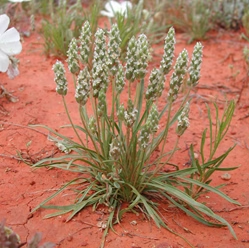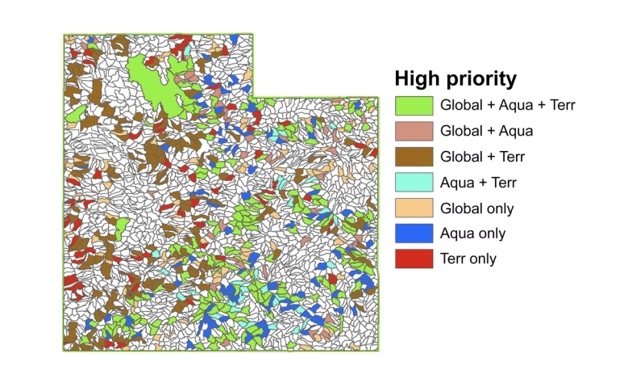In recent years, climate change research has indicated that some of Earth’s most climatically extreme environments—ice caps, rainforests, and the high, arid deserts of the Colorado Plateau—may be most at risk of rapid, irreversible change. Though the ecosystems of Grand Staircase-Escalante National Monument (GSENM) are indeed adapted to extreme dryness and high temperatures, what can we expect to happen as global warming intensifies? As a decades-long drought continues to parch the Southwestern U.S., research about how the region’s plants may respond has sought to address this question, seeking conservation strategies to quicken adaptation and preserve these indispensable desert communities.
Meet Plantago patagonica, a small, wooly, annual plant native to GSENM that can be found growing in sandy substrates within the Monument’s desert grasslands and Pinyon-Juniper woodlands. P. patagonica’s native range extends throughout western North America at elevations between 1000-7100 feet and can be recognized by its long, basal leaves and cluster of small, white flowers forming a “spike” at the top of each stem. The plant was the subject of a recent study by Dr. Kyle Christie and colleagues of Northern Arizona University and Michigan State University. These researchers were interested in the capacity of P. patagonica specimens sourced from the Colorado Plateau to withstand and adapt to drought conditions. To examine this, they collected and grew P. patagonica from ancestral herbarium-preserved seed (collected 2003-2014) and from modern seed, subjecting the adult plants to artificially-induced drought conditions in a greenhouse setting. By comparing the fitness of ancestor plants to individuals from their descendant populations in experimental drought conditions, researchers determined how P. patagonica populations evolved over the past two decades in response to drought, accumulating traits that promote survival and reproduction in an increasingly dry environment. Surprisingly, descendant plants were shown to allocate more resources to their roots, have larger seed mass, seed numbers, and leaf mass, and have higher rates of reproductive effort and seedling survival than their pre-drought predecessors. This research suggests that adaptation by natural selection is not strictly a lengthy process taking place over millennia. Instead, plants may adapt to new stressors in just a few generations.

Plantago patagonica (Photo credit: Max Licher
While evidence of P. patagonica’s rapid adaptation to climatic stress is indeed promising, there is still great concern over whether the larger ecosystems of Grand Staircase-Escalante will be able to overcome climate stress as swiftly or as gracefully as P. patagonica. Responses to climate stress may be dissimilar among species of single plant communities, for example, meaning that we cannot expect stable, community-wide adaptation as the climate shifts. Another recent study by Dr. Kathryn Thomas and colleagues from the U.S. Geological Survey out of Tuscon, Arizona used biogeographical modeling to analyze 66 dominant plant species from 29 plant communities in the Southwestern U.S. Researchers employed multiple future climate change scenarios to calculate predictions for how well-suited the habitat’s changing climate will be for plants’ survival needs. They then compared these predictions among species within the 29 communities to determine how similarly plants from a single community will respond to climate stress. The results of this modeling showed disparate and unpredictable measures of climate suitability among species, indicating that different plant species will not uniformly adapt to the changing climate of a shared habitat. The authors state that these results implicate “a cascade of unanticipated ecological responses and unprecedented challenges to resource management”.
Not only does this research complicate the optimistic results of the P. patagonia study, but it suggests that ecosystem dynamics are more complex than the sum of the interactions among their constituent species. Put differently, it is insufficient to focus conservation efforts on only individual species or communities. Instead, it is crucial that we also stabilize adaptive pressure across as large a scale as possible. We can start by eliminating anthropogenic activities directly responsible for ecological disruption, while at the same time extending the social and financial support for conservation to the plants and wildlife being affected by climate change.
Indeed, watersheds within and around GSENM have long been identified as highly important conservation refugia for species and communities placed at risk by climate change. Most recently, Dr. Edd Hammill and colleagues of Utah State University were interested in identifying which watersheds in Utah should be prioritized for future land management and conservation efforts. By comparing the locations of key habitats for species of high conservation need to these regions’ projected change in relative and absolute temperature by 2100, researchers determined that GSENM and the surrounding region of south-central Utah accommodates many essential habitats which are projected to resist drastic temperature change over the next 80 years (see Figure below). These watersheds represent the highest conservation priority because of their capacity to remain climatically robust and maintain biodiversity well into the uncertain future of global temperature rise.
Designating these watersheds as areas of conservation priority does not suggest that other watersheds are any less important for conserving stable and functional ecosystems. Rather, the hope is that managers focus limited resources on those delicate and important ecosystems which have the best chance of adaptation and survival. This idea is key for any conservation effort entertaining triage—the ultimate goal is for ecosystems to be able to support themselves, without either hindrance or support from human activities.

Figure 1. UTAH’S TEMPERATURE REFUGE WATERSHEDS (adapted from Hammill et al. 2024). Distribution of watersheds Utah identified as especially resistant to temperature change by 2100 and containing key habitat for species of great conservation need. Color coding indicates the watershed’s status as high-conservation-priority for aquatic species (Aqua), terrestrial species (Terr), and all species surveyed (Global). South-central Utah contains a hotspot of high-conservation-priority refuge watersheds for key aquatic and terrestrial habitat.
Though all three studies advance uncertainty in plants’ response to global warming within and beyond the Monument, one thing remains clear – conservation efforts are paramount to preserve at-risk ecosystems. As demonstrated by the variable climate-suitability predictions of Thomas et al., we cannot forgo expansive conservation work expecting all plant species to adapt as rapidly as P. patagonica. Likewise, the broad spatial distribution of high conservation priority watersheds across the state shown by Hammill et al. attests to the interconnectedness of at-risk ecosystems and the immense scale of conservation initiative required to preserve them. The uncertainty within this research does not merely illustrate the limits of our predictive power in the face of climate crisis or the great lengths remaining to reach necessary conservation goals. It also serves as a reminder that as climate change unpredictably and broadly alters ecosystems, what may seem marginal today might prove to be essential tomorrow.
– Jack Behrens, GSEP intern
References:
Christie, K., N. R. Pierson, L. M. Holeski, and D. B. Lowry. 2023. Resurrected seeds from herbarium specimens reveal rapid evolution of drought resistance in a selfing annual. American Journal of Botany 110(12): e16265.
Thomas, Kathryn A., Brett A. Stauffer, and Christopher J. Jarchow. 2023. “ Decoupling of Species and Plant Communities of the U.S. Southwest: A CCSM4 Climate Scenario Example.” Ecosphere 14(2): e4414.
Hammill, E., L. Berkeley, S. Lindsey, M. Wheeler, and P. Thompson. 2025. Identifying temperature refuges in Utah using temperature, biota, and habitat data. Journal of Wildlife Management 89:e22667.
Taylor, Ronald J. (1994) [1992]. Sagebrush Country: A Wildflower Sanctuary (rev. ed.). Missoula, MT: Mountain Press Pub. Co. p. 118. ISBN 0-87842-280-3. OCLC 25708726
Smith, Sue. “Plantago Patagonica – Woolly Plantain.” Yavapai County Native & Naturalized Plants, University of Arizona, 13 Dec. 2022, cales.arizona.edu/yavapaiplants/SpeciesDetailForb.php?genus=Plantago&species=patagonica.

